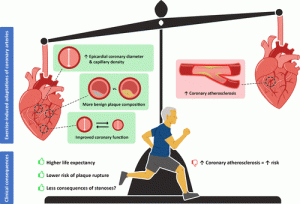Cardiovascular disease comprises of various diseases of the heart and blood vessels, including coronary heart disease, heart failure, high blood pressure and stroke. It is now the cause of roughly one-third of all deaths around the world. For all cardiovascular related conditions, physical inactivity is now recognized as a major contributing factor to cardiovascular disease, where exercise reduces this risk by half.
Coronary heart disease, the most prevalent form, is characterized by a narrowing of the inside of the blood vessels supplying the heart. Cells lining the interior of these blood vessels become damaged, possibly in response to high blood pressure, high levels of cholesterol. As a result, smooth muscle cells proliferate and move into he inside of the blood vessel, narrowing the diameter and restricting blood flow and delivery of oxygen and nutrients to varies areas of the heart muscle. This process is called atherosclerosis. Primary risk factors for cardiovascular disease include the following;
- Family history of heart attack or heart disease
- Cigarette smoking: current smoker or having quit less than six months prior
- Hypertension: where systolic blood pressure is greater than 140 and diastolic is greater than 90
- Obesity
- Sedentary Lifestyle
- Dyslipidaemia
A lot of these risk factors can be prevented by lifestyle modification, including regular physical activity where it is now widely recognised as an effective means of prevention. Regular exercise has both direct effects, by strengthening the heart and making it a more efficient pump, and indirect effects, by altering many other risk factors. By completing regular exercise, these are the most common effects on cardiovascular disease risk factors.
- High Blood pressure: Lowers blood pressure in those with mild to moderate hypertension. This is due to changes in blood composition- due to increased blood volume, making it less viscous and easier for the blood to travel to the vessels. Along with this, exercise increases vasodilation of the blood vessels, reducing blood pressure.
- Blood lipids: May lower blood cholesterol level, but increases blood high-density lipoprotein levels
- Obesity: reduces body weight and body fat, along with increases in lean body mass
- Type 2 Diabetes; Prevents obesity, improves glucose tolerance and insulin sensitivity and reduces body fat levels
WHAT TYPE OF EXERCISE IS BEST FOR HYPERTENSION AND CARDIOVACULAR DISEASE?
Regular exercise is the first treatment recommended to lower BP and improve cardiovascular health, both in the public and in those people with hypertension.
- Aerobic exercise reduces resting BP and reduces BP during light exercise and daily activities. Additionally, aerobic exercise protects against developing hypertension in the future. These effects occur in both men and women, with normal or raised BP.
- Resistance exercise training (e.g. lifting weights) and isometric exercises (i.e. holding a contraction) also produces small, but measurable, benefits for BP. People with a resting systolic BP of 180 mmHg or more, or a resting diastolic BP of 110 mmHg or more, should postpone their exercise program and seek medical advice
THINGS TO REMEMBER
- It is important to discuss starting an exercise program with your doctor. Accredited Exercise Physiologists have advanced training in understanding the impact of exercise on specific chronic conditions. Exercise is usually very safe and beneficial whether or not BP-lowering (antihypertensive) medication is used. Depending on the type of medications being taken, it is important to ensure you have adequate hydration, appropriate warm up and cool down periods and to avoid exercise in very hot conditions.




